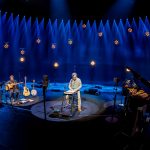
Passion Conferences are part of the Passion movement, a decades-old series of events created by Louie and Shelley Giglio. It has hosted more than a million students since its inauguration in 1997 in Austin, Texas for the purpose to “unite college students for a spiritual awakening in this generation.”
That first gathering had 2,000 attendees. Now in its 21st year, Passion 2019 attracted over 40,000 young adults, aged 18-25, to the three-day conferences held at four different venues in three host cities in early January.
Passion booked two arenas in Atlanta to serve the South — State Farm and Infinite Energy. Students from the Northeast met at The Anthem in Washington, D.C., while farther west, the Theatre at Grand Prairie outside of Dallas served as the fourth location.
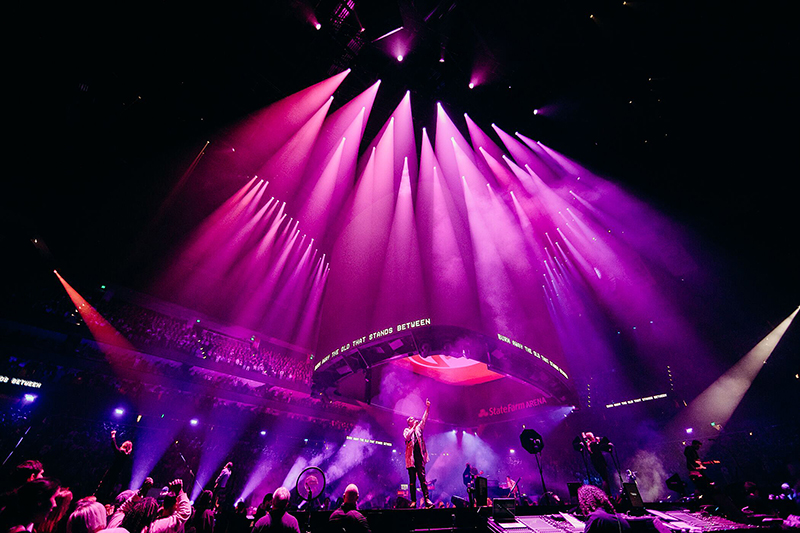
The Production Team
The core creative team at Passion Conferences includes Jonathan Sheehan, Chase Hall and Taylor Charboneau. Sheehan, as global brand curator and director of events, is responsible for all large conferences and events, overseeing everything from sales to programming. He has been with the Passion over 12 years. As Passion’s production manager, Taylor has been overseeing the production teams since 2016. Chase Hall, production designer for Passion City Church, has also served as the lighting designer for the Passion Conferences for the last three years.
Due to the complexity of managing four different venues simultaneously, Sheehan hired production designer Nathan Paul Taylor and U.K.-based production management company Black and White Live, led by Ian Cattle, for an assist. His company has produced the Passion Conference since 2013 and, prior to that, Cattle has worked with Passion on their World Tours.
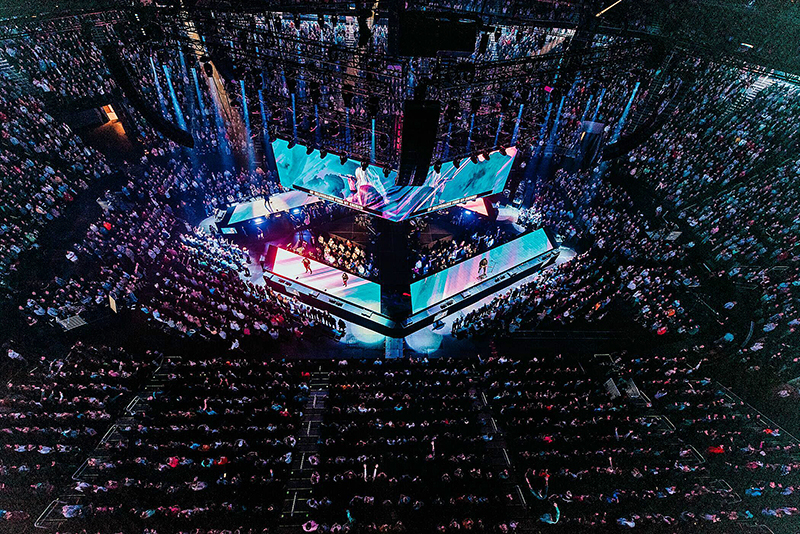
“We initially work alongside Passion to come up with a brief for creative designer Nathan Paul Taylor and then worked closely with Nathan to work through ideas and options based on the brief and the budget,” says Cattle. “They have a great lighting designer in Chase Hall, and he was instrumental in keeping the look cohesive from all four venues.”
One of the main visual framing objectives Passion sought was to keep the hanging LED walls simple in the 16-by-9 ratio, yet do so in a unique creative way. Passion went with an angular design nicknamed the “battleship,” due to the way that the truss and overhead LED screens were hung 45 degrees off axis to the room. Viewed from any side, the angles these displays give the of the prow of a ship, and lent themselves to that ratio. The perimeter stage decks were comprised of LED tiles that mirrored the angles in the air.
“From that point, It was a matter of re-imaging Nathan’s original design to fit the nuances and particularities of each venue separately, while remaining true to the overall concept,” says Cattle.
The Passion team turned to their preferred lighting vendor, Bandit Lites, to supply the rigs for the two Atlanta arenas. Local vendors Gemini LSV in Dallas and Afterglow Lighting in DC supported the theater productions.
“The Passion Conference is technically a hybrid of festival, rock show, corporate theater, and broadcast event,” says Chase Hall. “Bandit understands working under the conditions of all those environments, and the Bandit process of prepping shows is a huge part of our success going into this. Everything they do is nothing less than 100 percent.”
“Mike Golden, VP at Bandit Lites, is fantastic as a project manager, and his guys Jimmy Hatten and Gene Brian are very detail oriented, which just adds to our confidence of meeting Passion’s needs,” adds Ian Cattle.
Along with Cattle, producers Tim Green and Michele Jones, also from Black and White, do all the advance work before handing the project over to the production teams that execute the operation. One of Cattle’s known mantras is that “90 percent of the work is done beforehand, 10 percent is on event days.” In others words, it’s all in the prep.
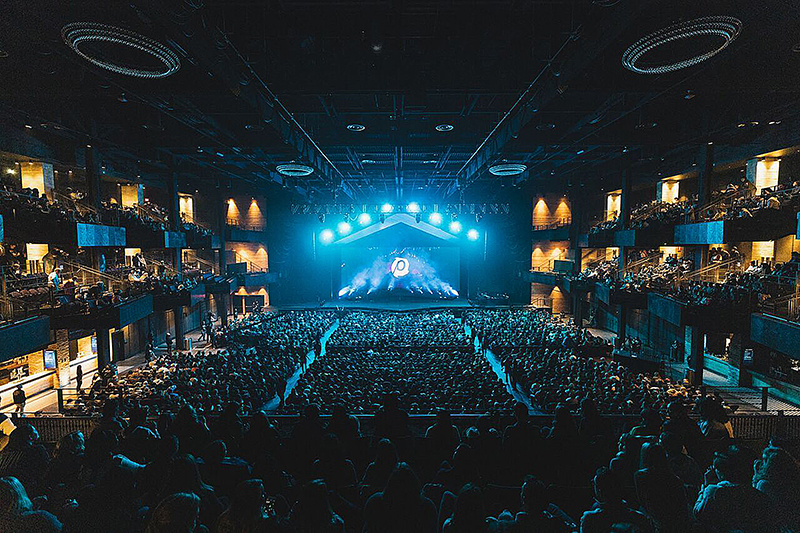
Upfront Preparation
“The key to the success of the Passion Conferences is all about the upfront preparation, communication, and documentation,” agrees Taylor Charboneau, noting that talks for this year’s event began in June. “We brought Ian and Nathan together our very first meeting, so design and production were working hand in hand from the start.”
Bandit supplied a previz package that included a grandMA console and one of each fixture in the rigs of the four venues. “The first piece to the lighting puzzle is technically preparing the show files completely, which requires an enormous amount of work up front,” says Hall. “We spent a month with WYSIWYG and Vector works at 515 [Passion HQ] during which time we supplied Ian and Nathan with modeling, fly through and program files. The result of that is we delivered a plug-and-play show file to each venue customized to that rig and that patch.”
This year, the Passion team hosted a pre-production meeting to go through the show from a purely functional standpoint; cue-to-cue. About 70 of the 440 crew members attended. All the technicians and engineers are told to go through the production run and try to find any weak links, gaps and glitches — and fix them.
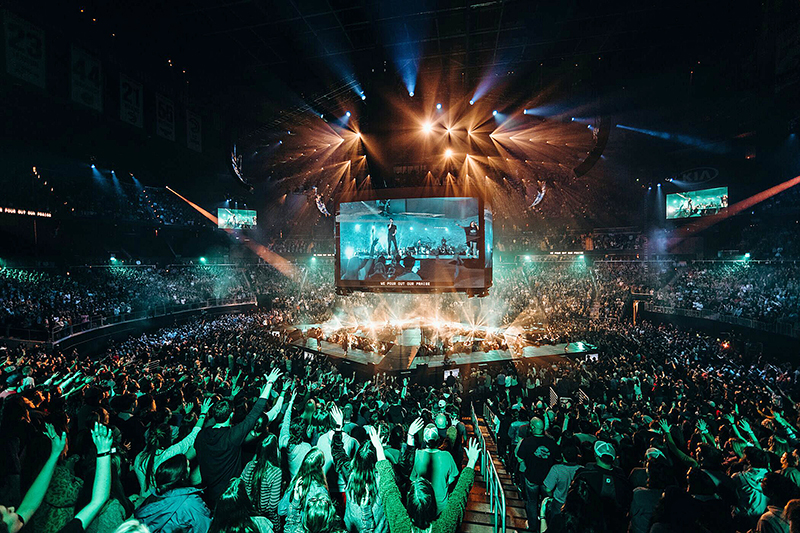
“The pre-production meeting Taylor organized was really a great idea on Passion’s part,” says Cattle. “It not only tightened the production up technically, it got many of our crew from all over the world in one room to meet and get to know one another.” Because, echoes Sheehan, “down-the-line is not an option. Once the show gets going, you are off to the races. There simply is no time to stop.”
Toward that end, Hall created a 30-page briefing document to give to his eight LD’s. It had detailed and clear-cut directions regarding what to do at every point of the show, complete with solutions should problems arise.
“Taylor did an incredible job leading our team,” says Hall “which included all vendor staff. The quality of people he brought in made the difference. We had LDs, some of which are the best show designers in the business today, handling key light only. And he stacked the positions in such a way that their seconds were just as strong, across the board in all departments.”
The core team at each venue was made up of four Black and White Live staff; a production manager, stage manager, production coordinator and a production assistant.
Design Goals and Solutions
“Overall, we wanted a cohesive, immersive visual experience for the attendees in each venue and the online viewers,” says Sheehan. “We want the people to feel like they are included in the show, not just watching it.” One of the goals for the simulcast was to provide the best quality visual experience possible. Black and White Live chose PRG Nocturne as their LED vendor. “The quality of screens, the latency on the images, even sightlines are factored into achieving this,” says Charboneau.
To achieve that, Hall adds, “Our goal from a visual and lighting perspective, is the moment people walk into the conference, they are inspired.” Woven into those priorities, “each location was treated with unique designs specific to the needs of its venue. While at the same time we also gave big nods between the venues so it felt like a unified event.”
During the three day conference, six sessions lasting just over two hours were comprised of multiple music acts and a 40-50 minute spoken word.
“In the process of building this conference, we’ve learned that people don’t mind watching a sermon on a screen,” says Sheehan. “For instance, the speaker in DC is broadcast in real time to our three other locations. The audience is cool with seeing that sermon on a screen. However, the experience starts to fall apart when it comes to presenting bands in that same format. Viewers just don’t engage with a musical performance on the screen as much.”
The uniquely shaped stage was designed by Taylor to facilitate quick changeovers, to accommodate the festival like schedule of bands or speakers. “Once we sound-check bands, nothing got unplugged,” says Taylor.
“A big part of Passion’s presentation style features the expanse of people in worship,” says Hall. “Lighting the crowd in a deep, unique and focused way is accomplished by lots of lumens and strong color — not just for cameras, but for the in room experience as well. We line the 100 levels sections in both arenas with bright color strobe options in order to add some textures for cameras and make the bowl shape of playing “in the round” draw the audience in.”
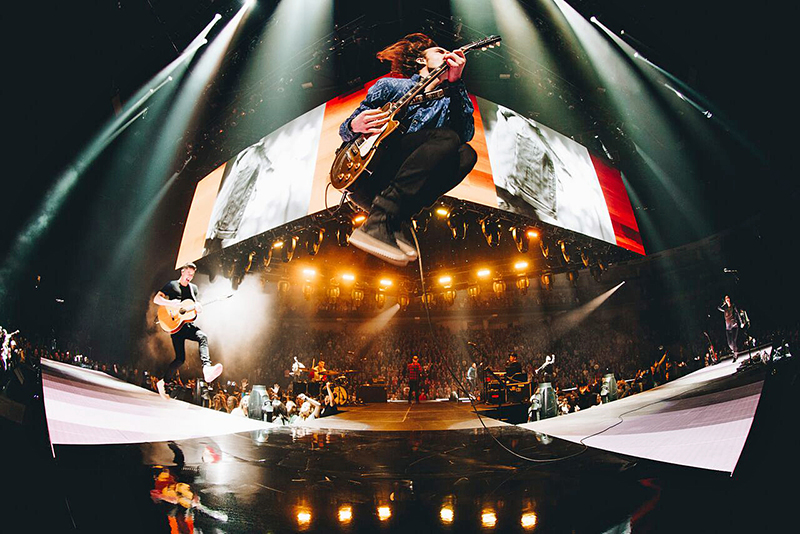
The Setup in Atlanta
The rigs Bandit supplied to the arenas in Atlanta each had more than 250 fixtures. Hall spec’d large quantities of broadcast fixtures including Vari-Lite VL3500 Washes and Spots. “The VL is the classic workhorse in the industry, and Bandit prepped the somewhat older fixture immaculately,” says Hall.
Martin MAC Viper Profiles filled in the rest of the system. For strobe/wash lights, TMB Solaris Flares and Philips Showline SL Nitro 510C were used. Besides the strobes, Hall was able to duplicate fixtures in all four rigs, which helped the looks stay cohesive across the conference locations.
Robe BMFL FollowSpots were used in both Atlanta venues with their pan and tilt disabled. Tension and drag was achieved through the servo motor Robe developed. A dedicated grandMA is manned for these alone. One of the LDs at FOH controls intensity and color parameters while the operators provide pan and tilt. “Having consistency in Robe products was great for key light,” notes Hall.
As is standard with Bandit; the rig is fully prepped, laid out, and fired up before going out the door. “We treat this huge “one off’ as if it going on tour for a year,” says Bandit’s Michael Golden. “It is of absolute critical mass that everything goes in without any missteps on the load in because there really isn’t any time to adjust.”
Bandit Lites has been working with the Passion Conference as a lighting vendor since 2009.

Communication and the Link
“Essentially we needed to satisfy three audiences,” points out Charboneau — “the in-room live production, the broadcast we streamed out to world, and the link connecting all four venues together. The goal there was to create seamless transitions venue-to-venue to create the feeling of an extended environment. Chase needs to make sure the show looks great in Dallas as well as when Atlanta is linked viewing Dallas it looks perfectly cohesive.”
Use of the link resolved latency problems across the four venues and played a huge part in the overall lighting; particularly key lighting. The opening night sequence provided quite a dynamic effect this year. SMPTE timecode was fired from the State Farm stage in Atlanta through the fiber trunk line via uncompressed video circuits to the three other venues.
All the lighting programmed in previz for the opening look was synced to every board across all four venues. The local operators didn’t touch their consoles. It was all done by the musical director standing on the State Farm stage with a simple press of a button.
The production used Riedel communications platform, which can trunk over IP. This enabled Hall to communicate directly with each LD in the separate venues just as if he were standing next to the person on headphones. Monitors for feeds from each venue were arrayed around Hall’s desk in Dallas. Through these, he could immediately access any adjustments necessary to the lighting. The setup is much like master control in a truck on-site.
Throughout the conference, many moments occur where one band would stream over all four venues. With the Riedel communication system, Hall could have a mini conference minutes before the band hit the airwaves, all four LDs communicating to help make sure the looks, gobos, color, luminosity and color temp were all the same.
Before each session, the Passion team repurposes the fiber line that links the four locations together. They have a room set up with a 60-foot screen and quad split and a camera to have a video conference. All the production and all the talent, including speakers and bands that are going to be in that session, go through for one last time what needs to happen during that upcoming session.
Cattle started out in Atlanta, overseeing the two staggered arena load-ins, then hopped a plane for the Dallas load in. His colleague at Black and White Live, Tim Green, handled PM duties in DC.
“My goal was to be available for team leaders to communicate with me easily,” says Cattle, noting how, by being in Atlanta at the center of communications, he was able to quickly respond to anything that needed to be done. And with Hartsfield Airport just up the road, he was able to quickly travel to Dallas once the Atlanta move-ins were underway. Streaming for the conference originates at the State Farm Arena in Atlanta. This is where three broadcast trucks are planted as well.
Not surprisingly, all the preplanning for the various conferences once again paid big dividends. “This year, Passion has gone as smooth as it has ever been, from beginning to end,” says Golden. “That goes back to the pre-planning on everyone’s part before it ever goes in the truck. I have a strong appreciation for the whole Passion Organization and their efforts and diligence to put this thing on every year.”
“It is amazing to see 40,000 kids and everything is so under control,” Golden adds. “The production team has a real good grasp of what they need to accomplish. Once you start looking at the schedule of this beast and realize you’ve got this team of Ian Cattle and his associate Tim Green who are actually overseeing four events at the same moment, it is very impressive. I just have say ‘hats off to these guys’ especially Jonathan Sheehan. He is the ‘top dog’ for Passion in my book.”
For more information, visit www.banditlites.com, www.blackandwhitelive.com and www.268generation.com
